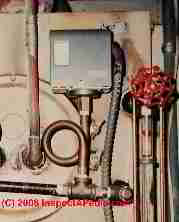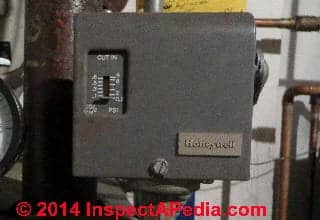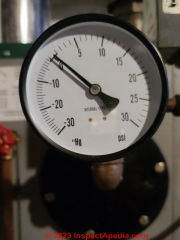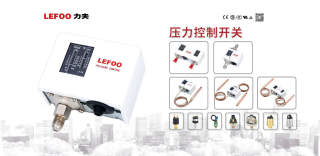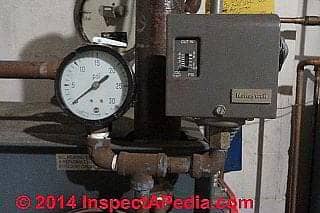 Steam Boiler Pressure
Steam Boiler Pressure
- POST a QUESTION or COMMENT about residential steam heating system controls, valves, gauges
Steam heating boiler pressures:
This article describes the normal operating pressure range for residential steam heating systems and for commercial or high-rise building steam heating systems.
We include citations of steam boiler explosions and describe probable differences in boiler explosion causes between early steam heat history and modern steam boiler use. The article also provides links to details about the pressure control and safety controls on steam heating systems & boilers.
This article series provides an illustrated inspection and repair guide to Steam Heating Systems. The page top photo shows a modern steam heating boiler.
InspectAPedia tolerates no conflicts of interest. We have no relationship with advertisers, products, or services discussed at this website.
- Daniel Friedman, Publisher/Editor/Author - See WHO ARE WE?
Steam Heating Boilers Operating Pressure Settings
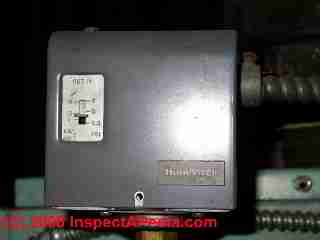 Residential steam heating systems are almost always designed to operate at very low pressures, typically around 0.2 psi to a maximum of 0.5 psi - that' s 1/2 of one psi. Click to enlarge and you can see the actual pressure settings on the steam boiler control shown at left.
Residential steam heating systems are almost always designed to operate at very low pressures, typically around 0.2 psi to a maximum of 0.5 psi - that' s 1/2 of one psi. Click to enlarge and you can see the actual pressure settings on the steam boiler control shown at left.
- 0.2 psi = 0.014 Bar or about 1378 Pascal of pressure - typical low-end of residential steam boiler pressure settings.
- 0.5 psi = 0.034 Bar or about 3447 Pascal of pressure - typical high-end of residential steam boiler pressure settings
Watch out: If your residential steam boiler is operating at higher pressures that may be an indication that a service technician or owner was having trouble getting heat distributed through the building. Rather than finding and fixing the problem, someone is trying to "force" the steam around the system.
[Click to enlarge any image]
High rise buildings and larger facilities using steam for heating may employ a high-pressure steam heating system. According to a University of Idaho engineering text we cite below, a 30 psi high pressure steam system might provide sufficient pressure to deliver steam heat to a building 40 stories in height. So we might see 15 psi for a 20 story building steam system.
- 20 psi = 1.4 Bar or about 137900 Pascal of pressure - typical low-end of high-rise building steam boiler pressure settings.
- 40 psi = 2.8 Bar or about 275790 Pascal of pressure - typical high-end of high-rise building steam boiler pressure settings
Above: the pressure in a steam boiler might indeed fall to zero or very close to zero when the boiler's burner is OFF and the system has cooled down. The steam boiler pressure on the gauge and pressure setting on the pressure control (gray box at upper right) are both normal at this installation observed in Poughkeepsie, New York in January 2023.
Why Might Steam Pressure Be Set Too High?
An experienced steam heat service technician will look at the operating pressure of your steam heating boiler and if it is not set to a normal level, the technician will look for the reason. Examples of problems that can affect the flow of steam heat through the system, leading to attempts to over pressurized the system include
- Blocked condensate returns at individual steam radiators
- Cold steam heat radiators
See STEAM HEAT RADIATOR REPAIR - Steam radiators tipped the wrong way
- Improperly relocated steam piping that has the incorrect slope
- Radiator valves that are not operating,
- Radiator steam vents that are not operating properly (most-common)
see STEAM VENTS - Steam traps clogged by rust, blocking condensate from leaving the radiator
see STEAM TRAPS
For details about radiator problems see RADIATORS for ROOM HEAT or select a topic from the closely-related articles below, or see the complete ARTICLE INDEX.
Watch out: do not modify a steam boiler pressure control switch to try to force steam heat to cold radiators or to higher floors. Doing so makes the system less efficient, fails to find and correct the underlying problem, and in some situations it could make the heating system unsafe.
Steam Boiler Pressure Control Safety Switch Operation
The pressure control switch on a steam heating boiler is designed to shut the heating system down should unsafe high pressures develop.
As we emphasize at our description of pressure gauges on a steam boiler, residential steam heating systems are almost always designed to operate at very low pressures, perhaps around .5 psi - that' s 1/2 of one psi.
You should see similar settings on the pressure gauge and on the steam pressure control switch (the gray box our photos of steam pressure switches shown here) on your boiler.
Because the operating temperature, pressure, and form of heat distribution are different from hot water heat (typically 20-30 psi of hot water), steam boilers (typically less than 0.5 psi steam) use use controls that monitor steam pressure operated controls like the Honeywell steam pressure control shown below.
Reader Question: the gray box on my steam boiler is set under 2 psi but the boiler pressure is 7-8 psi. Is this normal and safe?
 The gray box on my steam boiler is set low (less than 2psi) but the glass pressure gauge is reading 7 or8 at times. Is this normal /safe? - Brian 11/21/12
The gray box on my steam boiler is set low (less than 2psi) but the glass pressure gauge is reading 7 or8 at times. Is this normal /safe? - Brian 11/21/12
Reply:
Brian,
One wouldn't expect a boiler to blow up at 14 psi, but I agree that the system is not set nor operating at safe normal pressures. I suggest calling a service tech promptly.
Usually residential systems operate at lower pressures, less than 1 psi, often around 0.2 to 0.4 psi.
Since your steam boiler pressure control valve is set under 2 psi and the boiler pressure is way over that, and assuming that your steam boiler gauge is working and not "stuck" at an abnormal reading , the problem may be the pressure control valve itself.
See STEAM PRESSURE GAUGE
or
See PRESSURE SWITCH, STEAM BOILER.
We discuss how to set heating system pressures for both hydronic boilers and steam boilers over
at PRESSURE & TEMPERATURE SETTINGS, CONTROLS
Also see RELIEF VALVE, TP VALVE, STEAM BOILER.
Reader follow-up: changing out the steam pressure control valve did the trick
got the tech. he took off the gray box on my newly installed williamson boiler (2 weeks ago) and replaced it with the one from my older rotted out 12 year old Burnham! both gray boxes are honeywell and seem to be identical. works ok now. go figure!
Steam Boiler Pressure Gauge and Normal Pressure Ranges
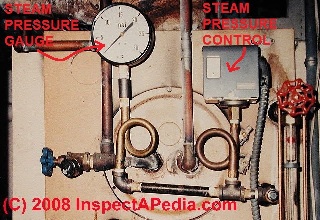 Pressure and Temperature gauge on steam heating boilers:
Pressure and Temperature gauge on steam heating boilers:
Residential steam heating systems are almost always designed to operate at very low pressures, perhaps around .5 psi - that' s 1/2 of one psi.
You should see similar settings on the pressure gauge (at left in our photograph) and on the steam pressure control switch (the gray box at right in our photo) on your boiler.
Details about gauges on steam heating equipment can be read
If your heating system uses forced or gravity circulated hot water rather than steam, controls and gauges are different:
see GAUGES on HOT WATER BOILERS
PRESSURE GAUGE, BOILER for more details about pressure gauges on hydronic (hot water) heating boilers. These are not steam systems.
Reader Question: proper setting for a Honeywell PA-404-A 1099 Presstrol on a steam boiler
Does anyone know the proper setting for a honeywell pa-404-a 1009 prestrol control for a weil-mclane steam boiler - Rick 9/11/11
Reply:
Rick the exact pressure needed varies by installation but in a low pressure residential steam system the pressure range is usually between 0.2 and 0.4 psi.
Reader Comment: too-high steam pressure traced to a blocked sensor on steam pressure control
Pressure on gas steam boiler was rising far too high, so high that the pressure relief valve released twice when it hit 15 psi (as it was supposed to do). Good buddy who really knows his stuff checked everything from pressure valve to pressuretrol. Nothing . He then checked "pigtail" and found blockage .Problem solved!! - Ken 11/24/12
Reply:
Thanks for this note it may help other readers
Reader Question: 28 psi and water coming out of my return on my American Standard boiler
II have a pressure of 28 psi and water is coming out of my return how can i lower the water pressure from my steam American standard boiler - Ronald 1/13/2013
Reply: 28 psi on residential steam heat is very unusual, probably unsafe - shut the system off
Ronald,
Watch out: If your heater is a residential steam heating system it is operating at an abnormally high temperature and is unsafe. Turn the system off immediately and call your heating service company.
If your heater were a residential hot water heating boiler (hydronic heat) its pressure might be close to the upper end of normal operating pressure - and the leak at the valve could be due to a valve problem or to any of quite a few other causes. See RELIEF VALVE LEAKS for procedures to diagnose and fix leaky TP relief valves. See the links just below for information on how the steam heating system pressure is controlled and set.
Steam Boiler Accidents & Explosions
Steam boiler explosions early in the history of steam boilers were often related to leaks, loss of water in the boiler, absence of safety controls like the HARTFORD LOOP and LOW WATER CUTOFF VALVE. In modern steam boiler explosions we are of the opinion that other forces might be at work, such as improper maintenance, tampering or work performed by inadequately-trained personnel.
- Two steam boiler explosions occurring in September 1867 were reported in the New York TimesOn 15 September 1867. Paraphrasing and excerpting the original news article from the Times archives:
"At Springfield IL a boiler 24 feet long and 3 1/2 feet in diameter, was blown to pieces as if it had been paper; the flour mill in which it was situated was almost entirely destroyed. ... All the information that the public are likely to get regarding the cause of the explosion is the reporter's statement that the engineer was not in the room when the "accident" occurred, and that the iron of the boiler was probably defective ... " - Schweber, Nate and William Neuman, "They Moved to Find a Better Life. It Got Worse", The New York Times, 21 December 2016. Excerpting:
"... on Dec. 7. It was a “freak accident,” according to Mayor Bill de Blasio: A valve had come off a radiator in the room where the girls slept, filling the room with intense heat and steam. It was not clear how long the steam had been pouring out, or whether the girls’ cries had gone undetected. A neighbor, hearing the parents’ screams, called 911 at 12:08 p.m. Fifteen minutes later, the girls were declared dead.
...
Mr. Ambrose said that he and his wife were awakened at about 6 a.m. when a valve popped off the radiator in the living room, where they slept. They replaced it, he said, but did not check on the girls.
Ms. McGuire later went out to run errands, her husband said, and he fell back asleep — apparently never realizing that the radiator in the adjoining room where the girls slept had also malfunctioned. At about 11:45 a.m. Ms. McGuire returned to the apartment and soon went into the girls’ room to find them turning purple and blistering from the intense heat and scalding steam.
...
Police and city officials are investigating the episode but have yet to provide a detailed explanation of what occurred, other than to say that a valve came off the radiator in the girls’ room, allowing steam to escape."
References for Steam Heating System Pressures & Temperatures
- Holohan, Dan, "A Steam Heating Primer", HeatingHelp.com, (2014), retrieved 2016/12/21, original source: https://heatinghelp.com/systems-help-center/a-steam-heating-primer/
- "BUILDING HEATING SYSTEM DESIGN" [PDF], University of Idaho, lectures on thermodynamics, retrieved 2016/12/21, original source: http://www.webpages.uidaho.edu/mindworks/Thermodynamics/Lectures/L14/Buildling%20Heating%20System.pdf
- STEAM BOILER PRESSURE SWITCH - details about the steam boiler pressure control device used on residential steam heating boilers
- STEAM BOILER TEMPERATURE - Residential Steam Boiler Normal Temperature & Pressure Ranges
- STEAM HEATING SYSTEMS & CONTROLS - home
- STEAM PRESSURE GAUGE - how to read actual pressure in a steam boiler used for building heating
- STEAM VENTS - installed on radiators must vent air to permit the radiator to get hot.
All of the steam heating system controls described in our introduction are illustrated below and described in greater detail in individual articles found in this steam heat series.
...
Reader Comments, Questions & Answers About The Article Above
Below you will find questions and answers previously posted on this page at its page bottom reader comment box.
Reader Q&A - also see RECOMMENDED ARTICLES & FAQs
On 2023-02-27 by InspectApedia Editor - a vent that's clogged or failing means intermittent or too little heat
@Joey,
I can't advise increasing the steam boiler pressure as you suggest, though the exact effect can't be predicted by a brief text.
Increasing steam pressure is a too-common "band aid" repair done by a technician who doesn't know steam system operation.
Consider that if the heating system worked properly at original installation, then it was designed to work at normal low steam pressures such as in the 1 psi range.
If you're now having heat delivery problems, the most obvious first place to start is with the steam vents at your 250+ convectors. A vent that's clogged or failing means intermittent or too little heat.
So try replacing some of those vents, starting with the coldest convectors - most distant.
Other more costly trouble could be rust and scale clogging convector piping, but do the vents first.
On 2023-02-21 by Joey
In a 7 story, 88 unit midrise with Eastmond single pipe steam heating system (4M BTU @ 125 hp). Some steam supply pipes were retrofitted after failing decades ago. Running smoothly at 1 PSI. Only on extremely cold days does the system run adequately to provide heat to the most distant unit (D aperture in vent).
During periods of moderate OD temperature the unit remain cool when others may overheat. What effect will increasing the boiler pressure to 2 PSI have? Will we have to re-vent the entire building (250+ convectors) with 4s and 5s except for the most distant units Ds? Any other ideas?
On 2023-03-04 by InspectApedia Publisher - commercial high-pressure steam system hazards
@Kevin Keith Smith,
Note of Details for other readers:
1. An important distinction is that this reader's is a commercial high-pressure steam system -
not the subject of the steam boiler pressure on this page where we focus on low pressure residential steam heating systems.
The hazards that come from making a mistake in setting high pressure steam pressure are enormously greater in part because of not just higher operating pressure but higher temperatures.
A description of a high pressure steam system that can give insight into its extra controls and complexity compared with residential steam is at
STEAM BOILERS GENERATORS CONTROLS, PRATT
In contrast, residential "low pressure" steam systems like those described above on this page operate usually under 1 psi.
Some useful definitions and properties of steam:
"Saturated steam" or "dry steam" can be defined as steam in which all of the water molecules are in a gaseous state. Actually even high temperature/pressure saturated steam systems are not likely to operate at a perfectly-saturated 100% level. Dry steam is what's wanted for use in heating systems.
The temperature of steam will be about the same as the boiling point of water at that pressure, where the boiling point of water at 1 Atmosphere (sea level or about 14.8 psi) is 212F or 100C.
Increasing the pressure in a steam system by 1 psi raises the boiling point of water and the steam temperature by about 3 degF.
The boiling point of water and thus the approximate steam temperature at 95 psi is about 324 degF or 162 degC!
Un-saturated steam or "wet steam" contains some water (droplets) mixed in with the steam - such as what comes out of a boiling tea kettle. Wet steam, in a heating system, can be corrosive and might also be less efficient at heat transfer from steam to the radiating device.
Superheated steam is steam that's at a temperature above the boiling point of water at that pressure.
2. The reader is probably correct that his system's operating pressure could be adjusted,
but we don't know enough nor have enough information to speculate on a specific change, particularly where there are significant safety risks. This is a question for an on-site, high-pressure commercial steam technician or engineer.
The U.S. Department of Energy offers an online steam modeling tool for high pressure steam systems that "Calculates saturated liquid and gas properties for a given pressure or temperature using the IAPWS Industrial Formulation 1997." found at www4.eere.energy.gov/manufacturing/tech_deployment/amo_steam_tool/propSaturated
but
Watch out: readers should beware of modifying their steam system away from its original design without consulting an on-site expert. There are simply too many local variables in steam system requirements, operation, distribution, etc. for a "one-size-fits-all" off the cuff answer.
Besides inviting readers to scan through our steam heat articles and ask questions, here is a copy the contents of an easy-to-understand steam heat course offered by India's Bureau of Energy,
STEAM SYSTEM COURSE [PDF] Bureau of Energy, Government of India, 4th Floor, Sewa Bhawan, R. K. Puram, New Delhi - 110066 (INDIA) Tel: 011-26766700, retrieved 2023/03/03, original source: beeindia.gov.in/sites/default/files/2Ch3.pdf
On 2023-02-14 by InspectApedia Editor
@Kevin Keith Smith,
I know NOTHING about your institution's size, location, usage levels, etc.
Take a look at the section titled:
Relationship of Boiler Pressure to Water Temperature in Steam Boilers
And its accompanying table on this page
STEAM HEATING SYSTEM OPERATING TEMPERATURE
Where we mention a commercial boiler system operating perhaps between 20-40 psi.
Please also be sure to read about BLEVE explosions and the risk and danger involved at
BLEVE: BOILING LIQUID EXPANDING VAPOR EXPLOSIONS
On 2023-02-14 by Kevin Keith Smith
I work in an institution that has a steam boiler it provides steam for hhw, in addition to the central kitchen and laundry. Our setpoint is 95 psi, but we determine from the steam saturation table that we can lower the setpoint substantially. I would like to hear an opinion on this subject.
Thank You
Keith
On 2022-03-15 by Inspectapedia Com Moderator - checking the setting on the pressure switch
@David Ellwood,
Start by checking the setting on the pressure switch itself -
and compare that with the pressure setting specified in the manual for your specific steam boiler brand and model.
If you don't have the IO manual we may have a copy.
On 2022-03-14 by David Ellwood
@Inspectapedia Com Moderator,
Thanks so much for your quick reply! I agree it seems like pressure is the problem. How is pressure adjusted on a boiler? Is it simply by adjusting the setting on the pressure switch? The current maximum is shown as 7.5 psi. I could easily reduce that setting.
Do I really need to call a technician for that? Or is it likely the switch and or gauge are defective?
BTW: Smart thermostats require a c wire and are run off the power to the furnace. If the power fails for any reason, they stay on battery power and disconnect from WiFi. When the power returns, they reconnect automatically.
Since the thermostat went off line at the same time as the furnace, and it was back on line when the furnace was back, I would say the most likely explanation is that whatever tripped the furnace (my theory is the pressure switch) also cut power to the thermostat.
Since the thermostat is shown on most wiring diagrams as connected directly into the pressure switch, that led me to suspect the pressure switch was tripped. And then I saw the high pressure reading and sent you the note.
Thanks again,
David
It sounds like the problem is likely to be excess pressure so I will seek out someone to fix the problem. Thanks again for your help.
On 2022-03-14 by Inspectapedia Com Moderator - Weil McLean boiler controls
@David Ellwood,
Thanks that's an interesting, helpful and also confusing steam boiler controls question.
Occam's razor advice says we ought to choose the one simplest explanation and not look for multiple causes or coincidences.
But I hear at least two odd snafus.
1. your thermostat not connected to wiFi would mean it needs to be attended: re-connected, re-initialized, or a similar procedure, and while at it, if it's really not getting power then the low voltage transformer that supplies the thermostat (and often also some boiler controls) may be disconnected or have failed. So start by confirming that the thermostat is getting 24VAC and if not work backwards to find and fix the transformer or wiring to it.
2. A residential steam boiler, as you know, operates at very low pressure, often around 0.5 psi. IF we see pressure has been pushed to a higher number that usually means a service tech is not a steam expert and has tried to solve a steam flow problem by increasing pressure.
Usually the hydronic loop simply circulates actual hot water out of the boiler's lower section that will always have hot water therein.
3. Or there is some arrangement of your hydronic heating system and a heat exchanger whose design and operation is unclear to me sitting so far away and with just a shred of information about your set-up.
On 2022-03-14 by David Ellwood
I am a handy residential homeowner with mixed heating system, part steam, part recirculating hot water. I have a Weil McLean boiler which provides the steam and heats the recirculating hot water via a heat exchanger. A few weeks ago the system was serviced because the water temperature in the recirculating system was quite tepid.
They found an expansion tank had failed (full of water) and they replaced the expansion tank, 2 air vents, pressure/temperature gauge (on the hot water system), hot water relief valve, and our horizontal heat exchanger. Recirculating hot water heat was dramatically improved. To my knowledge all their changes were in the hot water section, not the boiler itself.
But at least twice since, the furnace refused to fire up when calling for steam or recirculating hot water and the house began cooling down. The venting blower was operating and normally and water cut off light was illuminated green as normal. I have a relatively new thermocoupler and the pilot was on, and the water was not low.
I tried turning the system off and on, but nothing worked. I did notice one odd thing. Our smart thermostat which controls the steam heat indicated it was disconnected from the internet, which Almost certainly means it was not getting power from the system and was operating on battery.
The house cooled considerably (outside temp in the 20s) in the evening, but sometime during the night the furnace came back on. And this morning I noticed the thermostat was connected to the internet again. Looking at the wiring diagram and reading your very helpful site, I suspected I might have a steam pressure/pressure switch problem.
To my amazement the pressure valve on the boiler was registered between 7 and 10 psi when the system was heating, and the shutoff seemed to be set to 7.5 psi. This seemed crazy high, but it was still operating when the pressure was reading 10 psi level.
When I turned down the thermostats, the pressure settled back down to less than 1 psi. Any advice would be most welcome.
On 2022-02-14 by Inspectapedia Com Moderator
@Disan Munoz,
Flying blind since I can't see your building, my GUESS is that those basement radiators are heating by hot water not steam.
It is common in buildings to heat radiators on the same floor as the steam boiler by circulating hot water out of the same boiler through those rads - and more-effective since you'd have a devil of a time pushing steam "down" into that heating loop.
On 2022-02-14 by Disan Munoz
I’m very new to the world of steam heating and have just come across a system that baffles me. Old three story home that was converted into a business. Used one boiler to heat all three floors and two basement radiators. Three above ground floors all have single pipe radiators but both basement radiators are the two pipe type.
They also seem to not have steam traps on them and one of them looked like it had an air vent on it. System seemed to be working fine until a recent boiler replacement. Now, the system still heats for the most part but short cycles and the basement radiator with the air vent is spitting out a good amount of water from it. Thoughts?
On 2021-08-16 by inspectapedia.com.moderator
re-posting without dis-allowed link:
LEFOO · 9 hours ago
Thank you very much for seeing this article broaden my horizons. As a staff member of a pressure switch manufacturer, I usually focus on products and rarely understand downstream applications.
This time I learned about the common sense information of boiler machines, and I am very grateful to everyone for your feedback on the market. We will further improve the quality of our products.
Moderator reply:
Thank you for the kind words, LeFoo Company (un-named writer). We include your product image below - a steam boiler pressure control produced by Lefoo, website lefoo [dot] com
To protect our readers from possible malware Comment Box does not permit posting of links nor does our policy permit posting of advertisements.
However we very much welcome technical content suggestions, questions, criticism, and in those cases we are quite able and pleased to cite and provide contact information (including website links) to content contributors. We can also be reached by the CONTACT link found at the top or bottom of any InspectApedia.com page.
On 2021-08-16 by inspectapedia.com.moderator
@Chuck Lambert,
The answer depends on the on-off cycling rate.
If your boiler is cycling on and off rapidly, every minute or so, then something's wrong, perhaps with condensate return flow or with a control switch itself.
On 2021-03-03 by Chuck Lambert
Should my residential steam boiler be cycling on and off on pressure while thermostat is not satisfied? Pressure control set at approximately 2 psi with a reset of 1 psi. My plumber originally told me that the boiler should not be cycling on pressure but now tells me that is normal.
On 2020-09-30 - by (mod) -
Tyler
Usually when someone is setting a residential steam boiler to abnormally high pressure it's because their system is not delivering steam to one or more of the radiators;
In turn, that's often because there is a piping or distribution problem such as clogged supply pipes, clogged condensate return, malfunctioning steam vents.
I agree that it's not a good solution to just push up the pressure. Ask your service tech to investigate and tell you (and me) what problem she or he finds.
On 2020-09-30 by Tyler
My boiler won't fire unless the pressuretrol is cranked up to 5psi. I don't want it to run that high, I want it to run between 0.5 and 1.5. Any ideas what is going on here?
On 2020-09-20 by (mod)
Reid
That gauge is the wrong one and won't be useful. You could replace it with a steam boiler low pressure range gage but take care not to create a bigger problem if the mount area is corroded
On 2020-09-20 by Reid
I have a medium residential steam boiler with a new 30PSI gauge on it. The gauge does not move at all. It was mentioned that the whole system only heats at about 0.5 PSI. The boiler's PRV is rated at 15 PSI. Do I need a 30PSI gauge, or can I downsize to a 15PSI so that the boiler's pressure gauge actually does something?
On 2020-02-25 - by (mod)
Thank you so much for the follow-up, RAS.
We have worked hard on this information and website for many years, seeking to provide researched, unbiased information, so I'm of course grateful when a reader finds it useful. No one knows it all, so working together helps us both.
I'd need to know more about the application, but in general, shutting down a boiler does not itself harm any equipment, but depending on what the boiler is doing, the temporary loss of heat can of course be a problem. A residential steam heat system won't ever be much above boiling (100C) as those operate at very low pressure.
Commercial and high pressure steam systems can run at much higher temperatures and of course have different controls and different safety concerns.
Whether or not your particular system can shut down the boiler for 24 hours probably depends on the application of the boiler and whom its shut-down affects as well as whether or not there is a backup or alternative system to keep critical functions working.
On 2020-02-24 by RAS
sorry, meant this as a reply
Thank you very much for your quick reply. You do, indeed respond promptly, as advertised above.
No, it was not a quiz question at all, and I realized before asking that there are too many variables and I provided way too little information to make any kind of definitive statement, nor did I expect one.
I am working with a facility on a project not directly related to utilities or steam. For whatever reason, it would be helpful to what I am doing if they would shut down their boiler for 24 hours, but I didn't want to ask something of them that they would not want to do, which would be the case if they were to lose temperature in the boiler. As long as its possible, I won't feel out of place or uncomfortable suggesting it.
Having visited this site for information in the past, I want to thank you once again and let you know that there are those of us out here who greatly benefit from and appreciate knowledge and expertise found here. You are a tremendous resource!
Thank you very much for your quick reply. You do, indeed respond promptly, as advertised above.
No, it was not a quiz question at all, and I realized before asking that there are too many variables and I provided way too little information to make any kind of definitive statement, nor did I expect one.
I am working with a facility on a project not directly related to utilities or steam. For whatever reason, it would be helpful to what I am doing if they would shut down their boiler for 24 hours, but I didn't want to ask something of them that they would not want to do, which would be the case if they were to lose temperature in the boiler. As long as its possible, I won't feel out of place or uncomfortable suggesting it.
Having visited this site for information in the past, I want to thank you once again and let you know that there are those of us out here who greatly benefit from and appreciate knowledge and expertise found here. You are a tremendous resource!
On 2020-02-24 - by (mod) -
RAS
Yes - 100C or 212F (boiling) is pretty hot. But, then, we have no information about the size, thermal mass, residual heat in the whole heating system nor its initial operating temperature, insulation, etc.
is this a quiz question?
On 2020-02-24 by RAS
When an industrial boiler is shut down, with the heating source off, would it you expect the residual temperature of the boiler to not drop below 100C within the first 24 hours it was down?
On 2019-09-10 - by (mod) -
Watts 1156 pressure regulator on cold water supply ?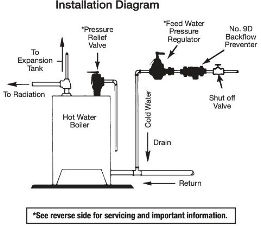 Duane
Duane
If you have a steam heating system and water is coming out of the steam vents then your system is flooded and your automatic water feeder is NOT WORKING. You need to call for repair.
A Watts 1156 Pressure Regulator is normally used on hot water (hydronic) heating boilers; you could install such a pressure regulator on the cold water supply line serving a steam boiler but NOT as a repair for the problem you describe and NOT as an automatic make-up water feed valve. This valve is a pressure reducer and is not intended for regular addition of make-up water that is required by a steam boiler.
See the Watts 1156 instructions at
WATTS PRESSURE REGULATOR 1156 MANUAL [PDF] retrieved 2019/09/09 original source: media.wattswater.com/1910265.pdf
In the ARTICLE INDEX you will find articles describing the necessary controls for steam boilers including
a LOW WATER CUTOFF and an AUTOMATIC WATER FEEDER for steam boilers: those are the proper controls for a residential steam heating system.
On 2019-09-10 by Duane - Can you use watts 1156 feeder on steam boiler
Water coming out bleeders on radiators
Will watts 1156 prevent that
Can you use watts 1156 feeder on steam boiler
On 2018-12-03 - by (mod) -
Yes at the boiler.
In the ARTICLE INDEX given at the end of this article please see details and illustrations at
the
HARTFORD LOOP
Article listed there.
On 2018-12-02 by Tim Kline
Should the top of the Hartford loop be higher than the condensate line on a gravity return system?
Question: 28 psi and water coming out of my return on my American Standard boiler
II have a pressure of 28 psi and water is coming out of my return how can i lower the water pressure from my steam American standard boiler - Ronald 1/13/2013
Reply: 28 psi on residential steam heat is very unusual, probably unsafe - shut the system off
Ronald,
Watch out: If your heater is a residential steam heating system it is operating at an abnormally high temperature and is unsafe. Turn the system off immediately and call your heating service company.
If your heater were a residential hot water heating boiler (hydronic heat) its pressure might be close to the upper end of normal operating pressure - and the leak at the valve could be due to a valve problem or to any of quite a few other causes.
See RELIEF VALVE LEAKS for procedures to diagnose and fix leaky TP relief valves. See the links just below for information on how the steam heating system pressure is controlled and set.
Question:
The HomeServ tech just left after installing a new auto water feeder, and the PSI gauge on my steam heater is off the chart, over 30 PSI. I shut it down and called HomeServ and they said leave it on and they'll come in the morning. How do I lower the PSI myself so I can leave it on tonight and my little kids (two with strep) don't freeze? Thanks! 2/22/2012
Reply:
Watch out: If the PSI gauge is showing abnormal pressure and the gauge itself is working properly the system is unsafe and should be shut down. Call someone else and fire that tech - from your description the system sounds unsafe
Question: too-high steam pressure traced to a blocked sensor on steam pressure control
Pressure on gas steam boiler was rising far too high, so high that the pressure relief valve released twice when it hit 15 psi (as it was supposed to do).
Good buddy who really knows his stuff checked everything from pressure valve to pressuretrol. Nothing . He then checked "pigtail" and found blockage .Problem solved!! - Ken 11/24/12
Reply:
Thanks for this note it may help other readers
Question: proper setting for a Honeywell PA-404-A 1099 Presstrol on a steam boiler
Does anyone know the proper setting for a honeywell pa-404-a 1009 prestrol control for a weil-mclane steam boiler - rick 9/11/11
Reply:
Rick the exact pressure needed varies by installation but in a low pressure residential steam system the pressure range is usually between 0.2 and 0.4 psi.
See details at STEAM BOILER PRESSURE
...
Continue reading at STEAM HEAT RADIATOR REPAIR - diagnose & repair, or select a topic from the closely-related articles below, or see the complete ARTICLE INDEX.
Or see PRESSURE & TEMPERATURE SETTING, CONTROL FAQs - questions & answers originally posted on this page
Or see these
Recommended Articles
- GAUGES, HYDRONIC BOILER - different pressure readings on hot water heating boilers
- RELIEF VALVE, TP VALVE, STEAM BOILER
- STEAM BOILER TEMPERATURE
- STEAM HEATING SYSTEMS & CONTROLS - home
- WATER FEEDER VALVE, STEAM
Suggested citation for this web page
STEAM BOILER PRESSURE at InspectApedia.com - online encyclopedia of building & environmental inspection, testing, diagnosis, repair, & problem prevention advice.
Or see this
INDEX to RELATED ARTICLES: ARTICLE INDEX to STEAM BOILERS
Or use the SEARCH BOX found below to Ask a Question or Search InspectApedia
Ask a Question or Search InspectApedia
Try the search box just below, or if you prefer, post a question or comment in the Comments box below and we will respond promptly.
Search the InspectApedia website
Note: appearance of your Comment below may be delayed: if your comment contains an image, photograph, web link, or text that looks to the software as if it might be a web link, your posting will appear after it has been approved by a moderator. Apologies for the delay.
Only one image can be added per comment but you can post as many comments, and therefore images, as you like.
You will not receive a notification when a response to your question has been posted.
Please bookmark this page to make it easy for you to check back for our response.
IF above you see "Comment Form is loading comments..." then COMMENT BOX - countable.ca / bawkbox.com IS NOT WORKING.
In any case you are welcome to send an email directly to us at InspectApedia.com at editor@inspectApedia.com
We'll reply to you directly. Please help us help you by noting, in your email, the URL of the InspectApedia page where you wanted to comment.
Citations & References
In addition to any citations in the article above, a full list is available on request.
- Weil McLain Model 78 Boiler Manual, Boiler for gas, light oil, Gas/Light Oil fired Burners, Installation, Start-up, Parts, Maintenance instructions, Part No. 550-141-705/0600, Weil-McLain Administrative Office, 999 McClintock Drive, Suite 200, Burr Ridge, IL 60527
Tel: 855-248-1777
Consumer Inquiries: 800-368-2492
Technical Services: 800-526-6636 Technical Support for Contractors Only.
If you are a homeowner and are experiencing a problem with your Weil-McLain equipment, the first step you must take is to contact your installer or locate an HVAC contractor in your area. Website: http://www.weil-mclain.com - The Steam Book, 1984, Training and Education Department, Fluid Handling Division, ITT [probably out of print, possibly available from several home inspection supply companies] Fuel Oil and Oil Heat Magazine, October 1990, offers an update, (see next item in this list). ITT Fluid Technology,
1133 Westchester Avenue
White Plains, NY 10604, tel +1 914 304 1700 fax +1 914 696 2950 www.ittfluidbusiness.com - Principles of Steam Heating, $13.25 includes postage. Fuel oil & Oil Heat Magazine, 389 Passaic Ave., Fairfield, NJ 07004.
- The Lost Art of Steam Heating, Dan Holohan, 516-579-3046 FAX
- Principles of Steam Heating, Dan Holohan, technical editor of Fuel Oil and Oil Heat magazine, 389 Passaic Ave., Fairfield, NJ 07004 ($12.+1.25 postage/handling).
- "Residential Steam Heating Systems", Instructional Technologies Institute, Inc., 145 "D" Grassy Plain St., Bethel, CT 06801 800/227-1663 [home inspection training material] 1987
- The Heat Efficiency of Steam Boilers, Bryan Donkin
- Steam Boiler Operation, Principles & Practice, James J. Jackson
- Domestic and Commercial Oil Burners, Charles H. Burkhardt, McGraw Hill Book Company, New York 3rd Ed 1969.
- National Fuel Gas Code (Z223.1) $16.00 and National Fuel Gas Code Handbook (Z223.2) $47.00 American Gas Association (A.G.A.), 1515 Wilson Boulevard, Arlington, VA 22209 also available from National Fire Protection Association, Batterymarch Park, Quincy, MA 02269. Fundamentals of Gas Appliance Venting and Ventilation, 1985, American Gas Association Laboratories, Engineering Services Department. American Gas Association, 1515 Wilson Boulevard, Arlington, VA 22209. Catalog #XHO585. Reprinted 1989.
- The Steam Book, 1984, Training and Education Department, Fluid Handling Division, ITT [probably out of print, possibly available from several home inspection supply companies] Fuel Oil and Oil Heat Magazine, October 1990, offers an update,
- Principles of Steam Heating, $13.25 includes postage. Fuel oil & Oil Heat Magazine, 389 Passaic Ave., Fairfield, NJ 07004.
- The Lost Art of Steam Heating, Dan Holohan, 516-579-3046 FAX
- Principles of Steam Heating, Dan Holohan, technical editor of Fuel Oil and Oil Heat magazine, 389 Passaic Ave., Fairfield, NJ 07004 ($12.+1.25 postage/handling).
- "Residential Steam Heating Systems", Instructional Technologies Institute, Inc., 145 "D" Grassy Plain St., Bethel, CT 06801 800/227-1663 [home inspection training material] 1987
- "Residential Hydronic (circulating hot water) Heating Systems", Instructional Technologies Institute, Inc., 145 "D" Grassy Plain St., Bethel, CT 06801 800/227-1663 [home inspection training material] 1987
- Heating, Ventilating, and Air Conditioning Volume I, Heating Fundamentals,
- Boilers, Boiler Conversions, James E. Brumbaugh, ISBN 0-672-23389-4 (v. 1) Volume II, Oil, Gas, and Coal Burners, Controls, Ducts, Piping, Valves, James E. Brumbaugh, ISBN 0-672-23390-7 (v. 2) Volume III, Radiant Heating, Water Heaters, Ventilation, Air Conditioning, Heat Pumps, Air Cleaners, James E. Brumbaugh, ISBN 0-672-23383-5 (v. 3) or ISBN 0-672-23380-0 (set) Special Sales Director, Macmillan Publishing Co., 866 Third Ave., New York, NY 10022. Macmillan Publishing Co., NY
- In addition to citations & references found in this article, see the research citations given at the end of the related articles found at our suggested
CONTINUE READING or RECOMMENDED ARTICLES.
- Carson, Dunlop & Associates Ltd., 120 Carlton Street Suite 407, Toronto ON M5A 4K2. Tel: (416) 964-9415 1-800-268-7070 Email: info@carsondunlop.com. Alan Carson is a past president of ASHI, the American Society of Home Inspectors.
Thanks to Alan Carson and Bob Dunlop, for permission for InspectAPedia to use text excerpts from The HOME REFERENCE BOOK - the Encyclopedia of Homes and to use illustrations from The ILLUSTRATED HOME .
Carson Dunlop Associates provides extensive home inspection education and report writing material. In gratitude we provide links to tsome Carson Dunlop Associates products and services.



